Considering adding a furry friend to your family in India? The journey of choosing the right dog breed is exciting, yet it can be overwhelming with the vast array of options available. This comprehensive guide, complete with Dog Breeds Names With Pictures In India, aims to simplify your decision-making process by highlighting some of the most sought-after and well-suited breeds for the Indian climate and lifestyle. From loyal guardians to playful companions, understanding the unique characteristics of each breed—their history, temperament, exercise needs, and grooming requirements—is crucial for a harmonious household. We delve into popular choices that have captured the hearts of Indian pet enthusiasts, ensuring you find a companion that perfectly matches your family’s needs. If shedding is a major concern when selecting a breed, you might find this list of dogs that don’t shed helpful in your search.
German Shepherd
German Shepherds are consistently ranked among the most intelligent, obedient, loyal, confident, and courageous dog breeds worldwide, making them exceptionally unique and popular in India. Their versatility as working dogs, family protectors, and companions contributes to their high demand.
A Brief History
Originally known as Alsatians, German Shepherds were primarily bred in Germany to assist shepherds in herding and protecting sheep. Initially, their role was more of a helper to farmers rather than a pet. The breed gained significant popularity during the First World War, solidifying its reputation as a capable and dependable canine.
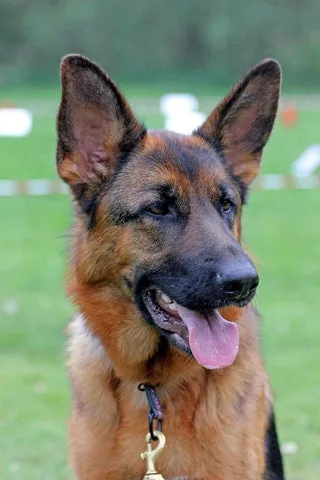 A majestic German Shepherd dog with a tan and black coat
A majestic German Shepherd dog with a tan and black coat
Key Features and Care
German Shepherds are agile and strong, characterized by square heads, erect pointed ears, and long, bushy tails. Their medium-length double coat can range from tan with a black saddle to solid black or white, and they are known for excessive shedding, especially during seasonal changes. This active and athletic breed requires substantial daily exercise for both mental and physical well-being. Grooming involves daily brushing, increasing to twice a day during shedding seasons, and baths every 10 to 15 days. Regular nail trims are essential to prevent discomfort and potential issues. Health screenings for conditions like degenerative myelopathy and elbow and hip dysplasia are recommended. Owners should also be vigilant for signs of bloating, a life-threatening condition requiring immediate veterinary attention.
Great Dane
For those who are drawn to large dog breeds, the Great Dane is an excellent choice. These gentle giants are not only affectionate companions but also vigilant and fierce guardians of the home. They are among the tallest dog breeds globally, with a Great Dane named Zeus once holding the record for the tallest dog ever.
A Brief History
Originating from Germany, the Great Dane breed has a history spanning over 400 years. Descended from Mastiff-like dogs, they were historically employed for hunting wild boars. Initially assets of the nobility, Great Danes were used for sport and the protection of carriages and estates, showcasing their power and imposing presence.
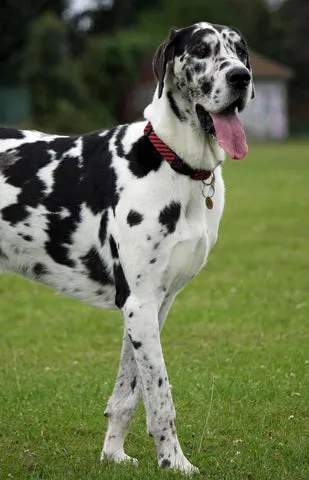 A tall and elegant Great Dane with a fawn coat
A tall and elegant Great Dane with a fawn coat
Key Features and Care
Great Danes are recognized by their long, muscular bodies and strong necks. They have medium-length tails and are considered light to medium shedders. Daily exercise is crucial for Great Danes, with intensity tailored to their age to protect their growing joints. Outdoor exercise on appropriate surfaces is preferred, as limiting activity to marble or tiled flooring can negatively impact their long-term health. Grooming is relatively simple; weekly brushing helps manage shedding, and occasional baths are sufficient. Keeping their nails short prevents discomfort and mobility issues. Great Danes are highly susceptible to gastric dilatation-volvulus (GDV) or bloat, a life-threatening condition. Many owners consider prophylactic gastropexy surgery to mitigate severe effects, following veterinary advice. Screening for hypothyroidism, cardiac diseases, and hip dysplasia is also important. For those seeking impressive yet gentle companions, these majestic canines make wonderful additions to the family. If you’re specifically searching for big house dogs that don’t shed, Great Danes offer a relatively low-shedding option among larger breeds.
Beagles
Derived from the French word “Beguele,” Beagles are adored globally for their charming personalities and compact size. They are excellent companions and family dogs, consistently ranking high among the cutest dog breeds in India. Their manageable size and amiable nature make them a popular choice for many households.
A Brief History
Beagles are descendants of hounds, primarily utilized for hunting due to their small stature and keen sense of smell. A variety known as ‘pocket beagles’ were even carried by hunters in their coat pockets, capable of tracking rabbits, jackals, and pigs with ease. Their historical role as scent hounds has contributed to their enduring popularity.
Key Features and Care
Beagles are muscular dogs with slightly domed skulls, long tails, and squarish muzzles. They possess a smooth double coat and shed moderately throughout the year. Beagles require significant exercise, at least an hour daily, and benefit from company (human or canine) during activities for their mental and emotional well-being. Mental stimulation through sniffing games and new toys is also crucial for their overall health. Weekly brushing helps remove loose hair and promotes healthy coat growth. They do not require frequent baths, and their nails should be trimmed regularly to prevent pain and discomfort. Beagles are susceptible to conditions such as hip dysplasia, epilepsy, luxating patella, and hypothyroidism. Weekly ear cleaning is necessary to prevent infections, and regular teeth brushing is also recommended.
Golden Retriever
Golden Retrievers stand out as one of the most beloved dog breeds in India. Once companions to Indian royalty decades ago, they are now cherished assets to dog fanciers across the country and are considered among the best dog breeds for families in India due to their gentle and friendly nature.
A Brief History
Primarily bred as bird-dogs for hunting waterfowl, Golden Retrievers were developed through a careful crossing of Spaniels, Setters, Newfoundlands, and possibly even a Bloodhound. This amalgamation resulted in a strong, water-loving, and expert swimming dog capable of tracking wounded prey and retrieving crippled birds with a soft mouth.
 A friendly Golden Retriever sitting in a field
A friendly Golden Retriever sitting in a field
Key Features and Care
Golden Retrievers are renowned for their beautiful, water-repellent fur coats, typically golden, light-golden, or cream, which can be wavy or flat. They feature feathering on the neck, legs, and thighs, along with a broad and robust head. This breed requires plenty of exercise; activities like hunting trips, long runs, and bike rides can help meet their high energy demands. Golden Retrievers are moderate, continuous shedders. Daily brushing (twice during shedding season) helps manage loose hair, and frequent baths are beneficial for keeping their coat clean and healthy. As with all breeds, nails should be kept short to prevent discomfort. Health screenings for elbow and hip dysplasia, retinal atrophy, and heart diseases such such as subvalvular aortic stenosis are important. Their ears and teeth should be checked often for signs of infection.
Pug
Named after the Latin word meaning ‘clenched fist,’ Pugs, with their endearing personalities and compact size, are among the most charming dogs, contributing significantly to their soaring popularity in India. These “big dogs in little bodies” are truly captivating.
A Brief History
Pugs have an ancient lineage, existing since 400 B.C., originating in China where they were primarily bred as companions for royalty. They also kept Tibetan Buddhist monks company, and Chinese emperors held them in such high esteem that they even employed guards for their protection. In India, the popularity of Pugs skyrocketed following Hutchinson Essar’s (a cellular network) advertisement campaign featuring Cheeka the Pug, which led to a sustained increase in demand for the breed.
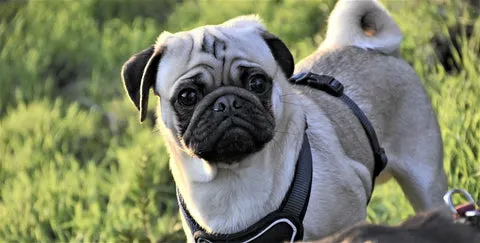 A cute Pug with its distinctive wrinkled face
A cute Pug with its distinctive wrinkled face
Key Features and Care
The most noticeable features of Pugs are their small, wrinkled faces, curled tails, and compact, square bodies with well-developed muscles. They have a fine, glossy coat that typically comes in light brown or black. Pugs require a moderate level of exercise, including play sessions and walks in a park. Due to their inability to tolerate hot weather, strenuous activity should be avoided when outdoor temperatures are high. Their smooth, glossy coat sheds moderately, and weekly brushing is usually sufficient to remove loose hairs. Frequent baths are not necessary, but their nails must be trimmed regularly. Special attention must be paid to their skin folds, which need to be thoroughly dried after baths to prevent infections. Pugs are susceptible to hip dysplasia, stenotic nares, corneal ulcers, and dry eyes. Their flat faces can also lead to breathing issues, such as reverse sneezing, particularly in hot and humid weather.
Pomeranian
The Pomeranian is considered one of the most unique dog breeds in India. Known as a favorite of Queen Victoria of Germany, this lively and loyal breed has become a popular choice for families across India, bringing joy and companionship.
A Brief History
Pomeranians are descendants of Arctic dogs, which were significantly larger in earlier times and capable of working in harsh, cold conditions. They were primarily used as sledge and load-carrying dogs, as well as for herding sheep. The breed was named after the Pomerania region, where they were selectively bred to achieve the smaller size we recognize today.
Key Features and Care
Pomeranians are characterized by their fluffy double coats and foxy faces with alert, prick ears. They have a squarish body shape, and their tails curl up and over their backs, complemented by a thick mane around their neck. Pomeranians need a moderate level of activity and enjoy running, playing, and going for walks. Due to their small size, it is vital to keep them supervised outdoors as they can easily be mistaken for small prey animals by larger predators. Pomeranians are prone to significant shedding and require frequent brushing to maintain their beautiful coat. Professional grooming for bathing, nail trimming, teeth brushing, and ear care is highly recommended. While generally healthy, Pomeranians should be screened for conditions such as luxating patellas, collapsing tracheas, seizures, and alopecia.
Shih Tzu
Also known as the Chrysanthemum Dog or Chinese Lion Dog, the demand for and availability of Shih Tzus in India have increased over the years, largely owing to their exceptional qualities as companion dogs. Their affectionate nature makes them ideal pets.
A Brief History
Shih Tzus originated in Tibet and were revered as symbols of royalty, often exchanged as precious gifts among Chinese and Tibetan royalty. The name “Shih Tzu” translates to ‘Little Lion’ in Mandarin, inspired by the God of learning, who was said to travel with a miniature lion dog that could transform into a large lion.
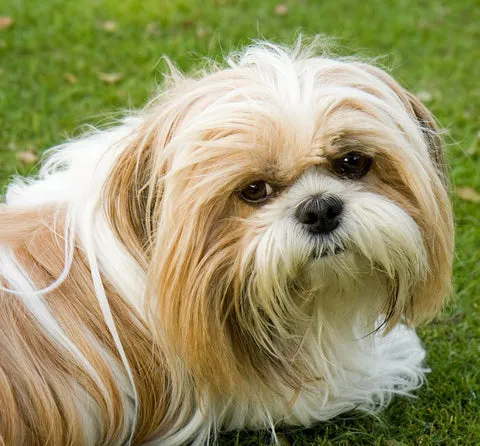 A fluffy Shih Tzu with a topknot
A fluffy Shih Tzu with a topknot
Key Features and Care
Shih Tzus are distinguished by their dense, long coats, featuring a heavy volume of hair on their heads. They can be found in solid colors such as brown or white and possess a muscular build with a deep, broad chest. This breed requires minimal exercise, consisting of short daily walks and indoor playtime. Shih Tzus necessitate daily brushing due to their long coats (which is why they are also known as hypoallergenic dogs). A bath every 10-15 days helps keep them clean. To protect their eyes and prevent irritation, the hair on their head must be trimmed or tied into a topknot. Their ears and nails also require regular cleaning and trimming. Professional grooming is often necessary to manage these needs. Known for their luxurious long coats, Shih Tzus are often considered a good option for those seeking dog breeds that don’t shed hair as their shedding is minimal and more like human hair. Shih Tzus are prone to health conditions such as hip dysplasia, cataracts, retinal atrophy, and corneal dryness, and should be screened accordingly.
Siberian Husky
The Siberian Husky often wins the title for India’s most unique dog breed. These blue-eyed wonders have seen a tremendous surge in popularity in India in recent years. They are classic Northern dogs, equipped with natural winter wear, making them exceptionally well-suited for cold temperatures.
A Brief History
The Siberian Husky was originally bred in Siberia by the Chukchi people, primarily serving as companions, guard dogs, and sledge dogs. Their popularity soared when they were instrumental in transporting antitoxins to Nome, Alaska, during the diphtheria epidemic, showcasing their incredible endurance and resilience.
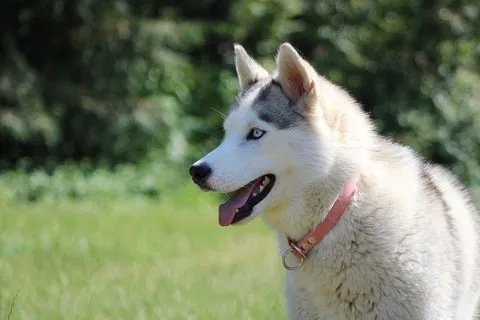 A Siberian Husky with piercing blue eyes
A Siberian Husky with piercing blue eyes
Key Features and Care
Siberian Huskies are characterized by their thick manes and a medium-length double coat, capable of withstanding temperatures as low as -75°F. Their coat colors range from black to pure white, sometimes including red and white shades. They have erect ears, straight necks, and a level topline. As athletic dogs belonging to the working group, Huskies have high exercise requirements. Regular physical activity ensures their mental and physical health. Siberian Huskies are double-coated dogs and are prone to excessive shedding, especially during their twice-yearly ‘blowing’ of the coat. Daily brushing is essential, and a de-shedding tool is highly recommended during heavy shedding periods. They are remarkably clean animals and do not require frequent baths. Like other breeds, their nails must be kept short to prevent pain and discomfort. While generally healthy, Huskies can be susceptible to juvenile cataracts and hip dysplasia.
Dachshund
This distinctively sausage-shaped dog is definitely a head-turner! The Dachshund’s lively and playful character, short coat, and small size make this breed easy to maintain and incredibly apartment-friendly, endearing them to many dog lovers.
A Brief History
The name Dachshund translates to ‘badger dog,’ a moniker earned due to their exceptional ability to hunt badgers. Historically, they were categorized into two sizes: standard-sized Dachshunds hunted wild boars and badgers, while miniature Dachshunds were primarily used for hunting hares and foxes, showcasing their versatility and hunting prowess across different terrains.
Key Features and Care
Dachshunds are easily identifiable by their very long bodies and short legs. They possess broad foreheads, long and pointed noses, floppy ears, curved tails, and deep chests. While small in stature, Dachshunds require regular exercise to stay fit and develop strong muscles, especially to protect their unique long backs. Owners should prevent them from running up and down stairs or hopping on and off furniture, as these actions can lead to spinal injuries. Dachshunds do not shed excessively, with smooth-coat varieties requiring less frequent brushing than long-haired ones. Their nails, like those of other breeds, must be kept short. Due to their long backs, Dachshunds are prone to intervertebral disc disease (IVDD) or slipped discs. Ample exercise and weight management are crucial to prevent this and obesity. They are also susceptible to ear infections if proper ear hygiene is not maintained. Their lively and playful nature, combined with a relatively short coat and small stature, makes them ideal for apartment living and easy to maintain. For those interested in cute medium sized dogs that don’t shed, Dachshunds offer a charming and adaptable choice with minimal shedding concerns.
Indies
Indies, also known as Pariah dogs, are indigenous to the Indian subcontinent. They are commonly seen as guard dogs or police dogs due to their intelligence and protective instincts. As a naturally evolved breed, they are found throughout India and are increasingly popular choices for adoption within the country.
A Brief History
This ancient breed is distributed across South Asia, and while their exact origin remains elusive, archaeological evidence suggests their presence for over 12,000 years. They served as hunting companions for various tribes throughout the country and are prominently featured in Indian art, culture, and heritage through sculptures, paintings, and folklore, reflecting their deep roots in the region.
Key Features and Care
Indies typically have a squarish or rectangular build, with a short double coat comprising a soft undercoat and a thick overcoat. They possess erect ears and a curled tail, with common colors including light and dark browns, white, black, and reddish-brown. Indies are friendly, protective, playful, loving, and intelligent, often exhibiting territorial instincts. Regular exercise, including walks, runs, and even swims, is essential for their physical and mental well-being. Without adequate activity, they may resort to destructive behaviors. Mental stimulation through sniffing games should also be provided frequently. This breed sheds very little and requires minimal grooming attention. They do not have strong body odors, making occasional baths more than sufficient. While well-suited for tropical temperatures, they may struggle in extreme heat or cold. Their nails must be trimmed to avoid pain and discomfort. Indies are considered one of the healthiest breeds, with very few genetic disorders such as hip dysplasia being rare. These indigenous dogs are known for their hardiness and minimal grooming needs, including very little shedding. For families looking for large family dog breeds that don’t shed in the Indian climate, the Indie dog presents a robust and low-maintenance option.
Frequently Asked Questions About Dog Breeds in India
Which dog food is famous in India?
Traditionally, boiled chicken and rice, or milk with roti, have been popular choices for dog food in India. For those who prefer alternatives to home-cooked diets, kibble is a common option. However, it’s important to note that feeding a dog only rice and chicken for extended periods may not provide sufficient protein. It’s best to consult a veterinarian for a balanced diet plan suitable for your dog’s specific needs.
Which dog breed is better for a family in India?
For dog lovers and prospective adopters in India, popular dog breeds suitable for families include Labradors, Golden Retrievers, Pugs, and Pariah dogs (Indies). Siberian Huskies, while beautiful, should generally be avoided due to their adaptation to cold weather, as the tropical climate in most parts of India can be harmful to them.
Which is the best suited small breed dog in India?
If you are seeking a small, easy-to-care-for, and apartment-friendly dog in India, excellent choices include Shih Tzus, Indian Spitzs, Pugs, Dachshunds, and Yorkshire Terriers. These breeds typically adapt well to smaller living spaces.
Which is the longest living dog breed suitable for India’s climatic conditions?
Indian Pariah dogs (or street dogs), Beagles, Golden Retrievers, and Chihuahuas are among the longest-living dog breeds known for their compatibility with India’s tropical climate. Their resilience and adaptability contribute to their longevity in the region.
Which is the best dog breed for a pet in the metro cities in India?
In metropolitan cities, where small apartments without lawns are common, the best dog breeds for urban dwellers in India include Pugs, Dachshunds, Beagles, Retrievers, Poodles, Indian Spitzs, and even Pariah dogs. However, these breeds require significant exercise and mental stimulation. Therefore, they should only be kept in apartments if owners can commit to daily outdoor activities for at least two hours.
Which dog breed is suitable for North Indian Climate?
For the northern parts of India, where climates can be cooler, suitable dog breeds include Bhakarwal dogs, Rampur Greyhounds, and Bully dogs. These breeds are better adapted to the specific environmental conditions found in North India.
Which dog breed is best for apartments in India?
For apartments in India, several breeds make excellent companions for families. Pugs, Dachshunds, Beagles, Retrievers, Poodles, Indian Spitzs, and even Pariah dogs are well-suited. The key, however, lies in ensuring they receive adequate daily exercise and mental stimulation outdoors for a minimum of two hours, as all dogs thrive with physical activity, regardless of their living space.
Choosing a dog is a significant decision that brings immense joy and companionship. By understanding the unique characteristics, needs, and suitability of various dog breeds, especially within the Indian context, you can make an informed choice that leads to a fulfilling relationship for both you and your new canine family member. Always prioritize responsible pet ownership, including proper care, nutrition, and regular veterinary check-ups.
